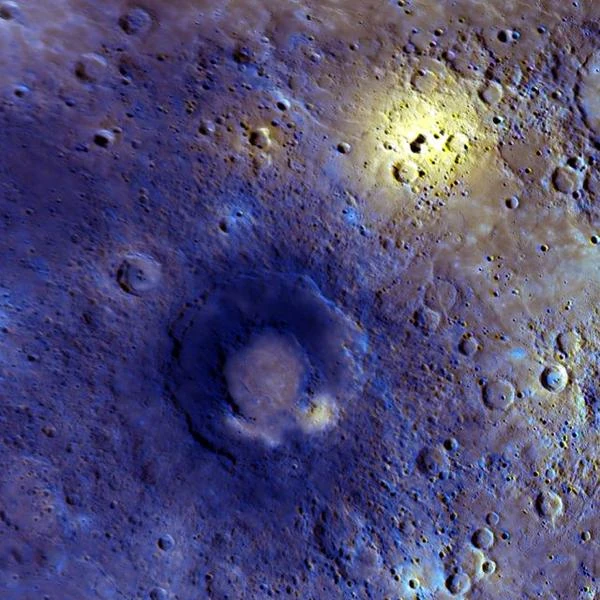
The MESSENGER mission (MErcury Surface, Space ENvironment, GEochemistry and Ranging), launched by NASA in 2004, aimed to study Mercury's internal structure, surface geology, magnetic field, and exosphere. The probe used multiple gravity assists from Earth, Venus, and Mercury itself before entering orbit on March 18, 2011.
The results revealed a sulfur-rich crust, a metallic core occupying more than 80% of the planet's radius, an asymmetric magnetic field offset by 20% to the north, and an exosphere composed of sodium, potassium, and oxygen.
Mercury is the closest planet to the Sun, at an average distance of about 0.39 astronomical units. This proximity results in very high solar gravity, making orbital insertion extremely energy-intensive.
To place a probe in orbit around Mercury, it is not enough to head toward the planet: the probe's orbital speed relative to the Sun must also be reduced to prevent it from being pulled directly into the Sun. The delta-v required for direct braking would exceed 15 km/s, far beyond the capabilities of conventional chemical thrusters.
Missions like MESSENGER therefore use gravity assists from Earth, Venus, and Mercury itself to gradually reduce orbital energy and achieve a stable orbit. This strategy reduces fuel consumption and keeps the probe within mass limits.
Additionally, prolonged exposure to intense solar radiation requires the probe to have sophisticated thermal protection. MESSENGER, for example, used a heat shield and specially orientable solar panels to keep its instruments within operational temperature ranges.
N.B.:
The combination of solar attraction, high initial velocity, and thermal constraints makes Mercury one of the most difficult planets to reach for a space mission. Every maneuver must be optimized for fuel consumption and thermal protection.
Approaching Mercury required exceptional energy management due to solar attraction. The probe traveled a complex path of over 7.9 billion km. Velocity corrections were on the order of a few hundred m/s, optimized through gravity assists. The energy-to-mass ratio had to remain below \( \Delta v \approx 15 \, \text{km.s}^{-1} \).
N.B.:
The energy-to-mass ratio in astronautics expresses specific energy, i.e., the change in velocity (\( \Delta v \)) available per unit of mass. For MESSENGER, reducing orbital energy to position itself around Mercury required decreasing its specific energy by about 30 km²/s², equivalent to several km/s of braking. This constraint could only be met by using successive gravity assists.
Mercury is not in synchronous rotation like the Moon with Earth.
If Mercury were completely tidally locked, it would always present the same face to the Sun (1:1 synchronous rotation).
However, radar observations in the 1960s showed that it rotates faster: 58.65 Earth days for one rotation on its axis.
Since its revolution around the Sun lasts 87.97 Earth days, this results in a 3:2 resonance: 3 rotations for 2 revolutions.
This means that the same meridian on Mercury faces the Sun every 2 orbital cycles (≈ 176 Earth days).
This resonance is the result of a compromise between tidal forces and Mercury's orbital eccentricity (\( e \approx 0.206 \)). The associated gravitational potential well favors a stable 3:2 state rather than 1:1.
| Mission | Agency | Period | Objectives and Major Discoveries |
|---|---|---|---|
| Mariner 10 | NASA | 1974–1975 | First multiple flybys (3), first close-up images, discovery of a global magnetic field. |
| MESSENGER | NASA | 2004–2015 | Orbital insertion around Mercury, complete surface mapping, discovery of polar ice, chemical composition, internal structure, offset magnetic field. |
| BepiColombo | ESA / JAXA | Launch: 2018 – Arrival expected: 2025 | Detailed study of the magnetospheric environment, high-resolution gravity and topography, validation of thermal and dynamic models. |
| Mercury Orbiter (old concept) | ESA (unrealized concept) | 2000s (canceled project) | Planned study of the exosphere and magnetic field, ultimately abandoned in favor of BepiColombo. |
| Shin'en | JAXA (concept only) | 2000s (unrealized concept) | Orbiter concept to study the exosphere and surface; not further developed. |
Sources: NASA – MESSENGER Mission, ESA – BepiColombo.